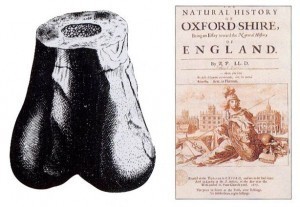Fossils!
Have you ever wondered what people in earlier centuries thought when they discovered the fossilised remains of dinosaurs? I've got to admit I hadn't thought about it – until I watched a fascinating programme on how people interpreted fossils in the days before Darwin's theory of evolution.
to admit I hadn't thought about it – until I watched a fascinating programme on how people interpreted fossils in the days before Darwin's theory of evolution.
Back in the Middle Ages, dinosaur footprints were blamed on the devil. Fossils from the quarry at Storeton in Cheshire were incorporated over the doorway of the nearby church at Higher Bebington in order to neutralise their evil powers. Dinosaur bones were also thought to be the skeletons of dragons. There were many myths of malign dragons, from the German dragon slain by Siegfried to the legend of Saint George. A huge dinosaur skull found in Austria in 1335 was said to be the skull of a dragon slain by a knight. This fitted the legend of the founding of the town of Klagenfurt, which had been built on swamps formerly inhabited by the dragon "Lindwurm." The town erected a statue of the dragon in 1590 and it was not until 1840 that the skull was identified as the head of a woolly rhinoceros.
 Oxford's Ashmolean Museum opened in 1683 and had a dinosaur bone as one of its main exhibits. In his book "The Natural History of Oxfordshire," Robert Plott, the First Keeper of the Museum, tried to work out what it was. He originally identified it as the bone of an elephant that had been brought to Britain by the Romans, but this theory foundered when a travelling menagerie came to Oxford and it included a live elephant. Plott measured the live elephant and saw it was significantly smaller than the bone. He also ruled out the possibility of it being from a horse or ox and concluded it was from a giant. The bone was again described in 1763 by Richard Brookes who called it "scrotum humanum" and compared its appearance to a pair of human testicles.
Oxford's Ashmolean Museum opened in 1683 and had a dinosaur bone as one of its main exhibits. In his book "The Natural History of Oxfordshire," Robert Plott, the First Keeper of the Museum, tried to work out what it was. He originally identified it as the bone of an elephant that had been brought to Britain by the Romans, but this theory foundered when a travelling menagerie came to Oxford and it included a live elephant. Plott measured the live elephant and saw it was significantly smaller than the bone. He also ruled out the possibility of it being from a horse or ox and concluded it was from a giant. The bone was again described in 1763 by Richard Brookes who called it "scrotum humanum" and compared its appearance to a pair of human testicles.
In 1788 a Scottish geologist claimed the earth was very ancient, a great deal older than scientists had previously imagined. In 1815 fossils of the bones and teeth of an enormous creature were uncovered at a slate mine in North Oxfordshire. These were found in a particular layer of rock and identified as very old. William Buckland, Oxford Professor of Geology, identified them as belonging to a very large carnivorous lizard forty foot long and eight foot high. This created a difficult challenge to the bible.
It was Richard Owen, an anatomist and the founder of the Natural History Museum who coined the name dinosaur or "terrible lizard." During the 1850s there was a craze for dinosuars and a Victorian dinosaur theme park was established at Crystal Palace which is still there. The "dinosaurs" were made of plaster and were extremely inaccurate in appearance but this is the oldest dinosaur theme park in the world.
lizard." During the 1850s there was a craze for dinosuars and a Victorian dinosaur theme park was established at Crystal Palace which is still there. The "dinosaurs" were made of plaster and were extremely inaccurate in appearance but this is the oldest dinosaur theme park in the world.
I do like the stories of the fossil hunters from the Regency period and very much enjoyed Deborah Cadbury's book The Dinousar Hunters about this early period in the identifying of the dinosaurs.
©2012 Nicola Cornick. All Rights Reserved.
.


